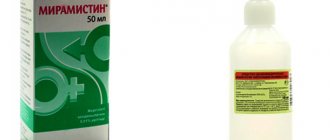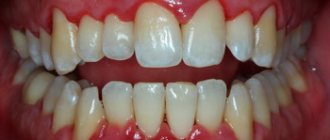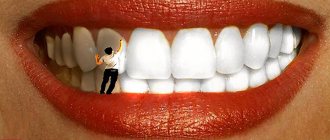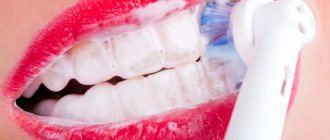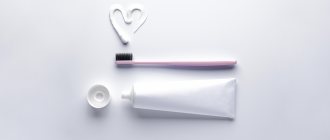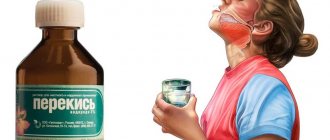One of the most popular and quite effective ways to whiten teeth at home is whitening with hydrogen peroxide. It is worth noting that this substance is also used by dentists for whitening in a stationary dental clinic. True, there it is not used in its pure form, but in combination with various components that reduce the destructive effect of peroxide on tooth enamel. For example, with remineralizing gels that contain glycerin. Many people also whiten their teeth with healing tea tree oils.
Therefore, when using peroxide yourself at home, you need to be careful.
Gum treatment
Each tooth is surrounded by soft tissue. They carefully protect its vulnerable spots from bacteria, the mechanical effects of food and acidity surges. The collection of these tissues around each tooth is called the gum.
- The oral cavity is a huge house in which teeth “live”.
- Each tooth has its own “apartment” - the gums.
A person feels better in a well-kept and renovated apartment. Let's make an analogy: teeth need healthy gums.
Let’s figure out what you need to be wary of and what to do if your fears become reality. Let's talk about the health of our gums.
implant surgeon, orthopedist, therapist, work experience: 12 years
The most common mistakes when dealing with symptoms of bleeding gums:
- stop brushing your teeth;
- use antiseptic rinses, gels and toothpastes (without consulting a specialist).
Such actions will only temporarily stop the symptoms, but will not prevent the recurrence of the disease.
Treatment methods for bleeding gums are aimed at stopping and stopping the development of chronic inflammation. Treatment is carried out depending on the severity of inflammation.
Dental
If you experience symptoms of bleeding gums, you should immediately contact your dentist who:
- will carry out diagnostics to identify the cause of inflammation;
- will perform ultrasonic teeth cleaning (for gingivitis) or curettage and treatment of periodontal canals (for periodontitis);
- will prescribe anti-inflammatory therapy, which lasts about 10 days. Treatment includes antiseptic rinsing with chlorhexidine solution and rinses of varying concentrations (depending on the degree of inflammation). Then a special gel is applied to the edge of the dry gum from the front of the dentition;
- will monitor the patient's condition after prescribing a course of treatment. Symptoms disappear within a few weeks and treatment can be stopped.
At home
For mild or moderate inflammation, treatment at home with folk remedies is possible.
A solution of sea salt or soda.
Salt water helps eliminate bleeding, pain, and also restores and strengthens gum tissue. To make a rinse solution, dissolve a tablespoon of salt or a teaspoon of soda in a glass of boiled water. You need to rinse your mouth three times a day for a week.
Herbal decoctions.
Such components can be found in any pharmacy. To rinse, you will need a solution of 2 tablespoons (1 filter bag) of raw material brewed in 500 ml of boiling water. The frequency of rinsing is carried out up to three times a day for a week. Decoctions of flowers (chamomile, calendula, yarrow) disinfect and relieve pain from inflammation and related diseases. A decoction of oak bark helps stop gum bleeding.
Hydrogen peroxide solution (disinfectant to stop bleeding).
This remedy is used to stop bleeding and whiten teeth. To make the solution, dilute one tablespoon of peroxide (concentration no more than 3%) with 200 ml of boiled water. You need to rinse your mouth three times a day for about five minutes for a week (the solution should not be swallowed). This product removes plaque and improves gum health.
Current methods of caries treatment
In traditional dental practice, treatment with hydrogen peroxide is not used. In addition, hydrogen peroxide, despite its pronounced antiseptic effect, cannot restore damaged tooth tissue or compensate for the lack of minerals in tooth enamel. Therefore, if you have symptoms of caries, you should not self-medicate. Seek help from a good dental clinic.
Today, caries is treated in two main ways - conservative or surgical. Conservative methods are non-invasive, that is, treatment is carried out without preparing the tooth.
- Remineralization of enamel.
The tooth is coated with compounds that contain phosphorus and calcium ions, the main mineral substances of tooth enamel.
- Fluoridation.
Fluoride-containing gels, varnishes, and pastes are applied to the surface of the teeth, which ensure saturation of the enamel with fluorides. They strengthen the surface of the teeth, increase the resistance of the enamel to the action of bacteria, and protect the teeth from calcium losses.
- ICON method.
Another minimally invasive method of treating carious lesions, which is carried out without drilling or filling the tooth. The dentist alternately applies several compounds to the surface of the tooth, the last of which seals the pores of the tooth enamel. This sealing protects teeth from the penetration of bacteria into deep tissues and prevents the development of caries.
These methods do not cause pain to the patient, so they can be performed without anesthesia. But they give an effective result only if the carious process is at the initial stage and there is no carious cavity in the tooth yet.
If there is a hole in the tooth, caries is treated surgically:
- Cleans enamel from plaque and tartar.
- An anesthetic injection is given if treatment for medium or deep caries is considered.
- The cavity is drilled out and all affected and dead tissue is carefully removed.
- The cavity is disinfected with antiseptics and its walls are coated with an adhesive composition, which will allow the filling to adhere better.
- An insulating or therapeutic pad is placed at the bottom of the cavity to protect the pulp or relieve inflammation.
- The tooth is filled with a suitable material and given its natural shape.
- Grinding and polishing are carried out to align the tooth with the bite and form a smooth, even surface.
A correctly selected treatment method helps to cope with caries at any stage, stop the development of the pathological process, and return the tooth to its natural appearance.
Indications and contraindications
Hydrogen peroxide is a cheap, effective remedy for a number of diseases. It is used in therapy:
- periodontal disease;
- stomatitis;
- fungal infections of the mucous membrane and gums;
- plaque on the tongue;
- bad breath.
But keep in mind that peroxide is not a universal remedy for all diseases and it has contraindications. Rinses and compresses cannot be used for:
- advanced deep caries;
- a large number of fillings;
- advanced stages of periodontitis, accompanied by increased bleeding of the gums;
- violations of the integrity of tooth enamel.
Regular use of peroxide does a good job of brightening tooth enamel.
The substance should also not be used by children under 12 years of age. If you doubt the advisability of hydrogen peroxide therapy specifically in your case, we recommend that you first consult with your doctor.
Teeth whitening at home with peroxide: caution is necessary!
Having chosen hydrogen peroxide as a home whitening product, you need to be extremely careful when using this substance:
- Do not swallow under any circumstances; if this happens accidentally, consult a doctor immediately.
- This substance should not be used by pregnant women and children under twelve years of age;
- stop the procedure if there is a feeling of discomfort or redness of the mucous membranes is observed;
- It is not recommended to whiten teeth with peroxide for people with deep wounds or mouth ulcers, as well as for those who have recently had their tongue pierced;
- choose exclusively 3% peroxide for whitening, do not use stronger concentrates;
- Those who have intestinal or stomach diseases should also avoid peroxide;
- check the body's reaction to peroxide before starting bleaching (apply the substance to the back of the hand for a while);
- This type of whitening is not recommended for those who have plates or braces in their mouth;
- do not use large amounts of peroxide, so as not to damage the integrity of the enamel;
- do not keep the product in your mouth for more than a few seconds;
- take breaks between whitening courses;
- There is no need to whiten teeth with peroxide for people with caries, increased sensitivity of enamel and bleeding gums;
- Regardless of the chosen method of whitening, after using peroxide, be sure to rinse your mouth thoroughly;
- eat no earlier than half an hour after the procedure.
In order for whitening to be effective and as safe as possible, you should use only fresh peroxide, which is stored in an airtight jar. In addition, you need to understand that hydrogen peroxide will only help if your teeth have darkened as a result of any external factors. If the yellowness of teeth is hereditary or was acquired while taking antibiotics, then peroxide is powerless.
Try ASEPTA PLUS Gentle whitening paste - it effectively fights plaque and deposits, gently whitens, returning teeth to their natural color. The effect is noticeable after the first 2-3 cleanings.
Prevention
Teeth should not be allowed to be “lazy”, so chewing food should be vigorous, and the food itself should be quite tough (include plant foods in the diet). Thus, a natural massage of the gums is carried out, and their cells are renewed faster. You can also massage your gums with circular movements of your thumb, and rinse your mouth with warm water before eating.
Visits to the dentist should be regular, otherwise it is extremely difficult to save teeth in advanced forms of periodontitis.
What to do if you have periodontal disease:
- Maintain oral hygiene
- Identify the true cause of periodontal disease (general or local causes)
- Stop smoking
- Change your diet (exclude sweet foods and include plant foods.)
Solution
Medicines with antiseptic and anti-inflammatory properties can quickly relieve gum inflammation at home. In addition to them, you can also use traditional medicine.
Dental gels and rinses
Medicines for gum inflammation can be divided into 4 categories:
- Gels and solutions based on chlorhexidine. The use of these drugs for rinsing or applying to the mucous membrane can eliminate pain and prevent the development of periodontitis.
- Rinse solutions based on furatsilin, chlorophyll, medicinal plants - rotokan, stomatophyte, chlorophyllipt.
- Special dental gels enriched with anti-inflammatory components, such as propolis, will also help relieve gum inflammation.
Dental gels are more effective in the oral cavity. Unlike oil-based ointments, they are better absorbed and stay on the mucous membrane longer.
Here are the most effective gels for relieving inflammation and swelling of the gums.
Cholisal
is a two-component dental gel used for the prevention and treatment of gingivitis, stomatitis and periodontitis. Helps relieve swelling and inflammation of the gums and effectively relieves pain in the problem area. The anesthetic effect of the drug lasts up to 8 hours.
Application:
20 minutes before meals 2-3 times a day.
Metrogyl denta
– antimicrobial gel based on metronidazole and chlorhexidine. It has an anti-inflammatory and powerful antiseptic effect against a wide range of microorganisms - causative agents of gingivitis and periodontitis. Analogs of the drug Dentamet, Asepta.
Application:
2-3 times a day for 7-10 days. The gel is applied to the problem area 30 minutes before meals.
Gengigel
– a preparation based on hyaluronic acid. Restores damaged gum tissue, covers the mucous membrane with a protective film, and increases local immunity of the oral cavity. Prescribed for all diseases of periodontal tissue.
Application:
3-5 days until the symptoms of gum inflammation disappear. Used as part of complex therapy.
For the best effect, before applying the dental gel, brush your teeth, rinse your mouth with mouthwash or saline solution, wipe and dry your gums with a gauze pad.
To prevent inflammatory diseases of the oral cavity, it is recommended to use fluoride-containing toothpastes and rinses.
Traditional medicine
In combination with medications, mouth rinses can reduce pain and swelling:
- Saline or soda solution. To prepare the solution, it is recommended to add a teaspoon of sea or regular table salt (or baking soda) to a glass of warm water. Rinse your mouth with the resulting solution once every few hours.
- Herbal solutions. Decoctions of oak bark, sage, chamomile and mint are ideal for relieving gum inflammation.
How to brew the solution:
2 tablespoons of dried oak bark or other phyto-raw materials are poured into 200 ml of water and the solution is heated in a water bath for 20-30 minutes. After this, the infusion is filtered and boiled water is added to a volume of 200 ml.
How to rinse:
for a few minutes, every hour or two. After rinsing, it is recommended not to eat or drink anything for 30 minutes.
For inflammation of the gums it is also recommended:
- eat flaxseed oil, fish oil and other products containing unsaturated acids;
- use a solution of hydrogen peroxide and essential oils with an antibacterial effect.
It is better to treat gum inflammation with folk remedies after consultation with a doctor and use folk remedies as an auxiliary therapy.
Why you need to rinse the wound
Open wound after tooth extraction
This is a tasty morsel for the proliferation of pathogenic bacteria.
There are a lot of them in the mouth, as they accumulate near stuck pieces of food and plaque. If the gums are not protected, bacteria can provoke an inflammatory process
, suppuration and swelling of the soft tissues in the wound area, and cause pain. It is better not to disturb the wound for a day after the operation, so that a blood clot can form and the bleeding stops. Then you need to start rinsing to protect the postoperative site from bacteria and speed up wound healing. Let's figure out what to rinse with.
Indications for rinsing
Some diseases of the mucous membranes of the mouth, gums and teeth can be easily treated with these affordable remedies. And in combination they give an even faster and better effect.
Diseases of the mucous membranes and gums
Rinsing the mouth with baking soda and hydrogen peroxide is indicated for diseases such as:
periodontal disease;
- gingivitis;
- stomatitis;
- periodontitis;
- other gum diseases.
To carry out the procedure, you can use a solution of both substances or of each of them separately. The result is achieved in both the first and second cases.
Both soda and hydrogen peroxide have disinfecting properties and the ability to kill many germs and bacteria. It is these properties that allow them to quickly cope with diseases of the mucous membranes of the mouth.
Dental diseases
Tested by many generations and proven to be effective in treating teeth, as well as in teeth whitening.
Rinsing teeth with peroxide solution is used to prevent caries and bad breath. It is great for additional cleansing of the oral cavity. Rinsing with soda solution can reduce pain and inflammation in case of dental cyst formation. This rinsing is also recommended for the treatment of caries.
Hydrogen peroxide in the treatment of caries
The cause of dental caries is the bacteria Streptococcus mutans, which forms dental plaque - a biological bacterial film. These microorganisms feed on sugars that enter the human body along with food, and as a result of their processing they form organic acids. The latter destroy enamel, dentin and other tooth tissues.
Thus, plaque poses a threat to the development of caries. At the same time, biological film is difficult to remove or destroy with modern antimicrobial drugs. Several years ago, a team of scientists conducted research and developed nanoparticles that can destroy the structure of dental biofilm, destroy pathogenic microorganisms and prevent the development of caries.
Nanoparticles consist of iron oxide, polysaccharides and some other substances. When exposed to an acidic environment (and bacteria in dental plaque produce a lot of organic acids), these nanoparticles begin to produce hydrogen peroxide. This compound has a powerful antiseptic effect, destroys pathogenic microorganisms, destroys bacterial dental films, thereby protecting teeth from carious lesions. As part of the study, scientists tested their development on volunteers and came to the conclusion that nano-sized particles effectively destroy tartar and destroy bacteria without causing damage to the enamel or disruption of the microflora in the oral cavity. According to the scientists' findings, the use of nanoparticles with a one percent solution of hydrogen peroxide destroys more than 99% of cariogenic bacteria.
Researchers have suggested adding such particles to toothpastes or mouth rinses, since the use of these products can be an excellent preventive measure for dental caries. The practical application of the development can only be discussed after successful clinical trials. But the antiseptic effect of hydrogen peroxide on cariogenic bacteria is beyond doubt.
Other recipes with hydrogen peroxide for periodontal disease
You can add soda or lemon to the peroxide. According to reviews, treating periodontal disease at home with hydrogen peroxide will be much more effective if you combine it with other ingredients.
For example, rinsing with sea salt and peroxide will help relieve inflammation. For this, 1 tsp is enough. Dilute both in a glass of warm water, and then rinse in the usual way. Herbal infusions are also used to treat and prevent gum disease. In this case, infusions of oak bark, sage, St. John's wort and plantain are suitable. Add 5-10 drops of peroxide to the prepared broth and rinse your gums with it. It is necessary to add peroxide to the glass immediately before the procedure, when the herb has infused for the allotted time and the decoction itself becomes less hot.
With soda
Hydrogen peroxide and soda are one of the popular methods for treating periodontal disease at home. To prepare the solution you will need dry peroxide, and it is better to use sea salt. If it is coarsely ground, make sure that it is completely dissolved in the water. Under no circumstances should the prepared solution be swallowed.
Ingredients:
- Dry peroxide - 2 tablets.
- Salt - 1 tsp.
- Water - 200 ml.
How to prepare : Mix all ingredients.
How to use : Rinse your mouth with the resulting solution 3-4 times a day. The duration of the procedure is 5 minutes. The course of therapy is 1 month.
Result : Washes away pathogenic microorganisms from the surface of the gums, stops bleeding, promotes the regeneration of soft tissues.
With lemon
At home, periodontal disease can be treated with hydrogen peroxide, baking soda and lemon. This product can replace toothpaste. You should not do this regularly - for prevention purposes, one procedure every 7-10 days is enough.
Ingredients:
- Baking soda - 3 g.
- Lemon juice - 10 drops.
- 3% hydrogen peroxide - 20 drops.
How to prepare: Add fresh citrus juice to the soda and stir thoroughly. Then add peroxide.
How to use : Brush your teeth with the resulting mixture; no need to rinse your mouth. After the procedure, you should not eat or drink for at least 15 minutes.
Result : Heals gums, promotes periodontal regeneration.
Is it possible to gargle with peroxide?
Only a doctor can correctly diagnose and prescribe treatment. To effectively get rid of tonsillitis, consult a specialist.
According to the instructions for use, peroxide is used as a treatment for the pharynx in acute tonsillitis, gingivitis, stomatitis and other pathologies. For treating mucous membranes, a 0.25% solution of hydrogen peroxide is acceptable1. When rinsing, microbial contamination in the throat decreases and inflammation decreases. Lubricating the mucous membrane of the tonsils with a cotton swab dipped in a solution is also used, which helps to avoid unwanted effects on the rest of the epithelium. On the other hand, peroxide does not act selectively on tissues, that is, it damages, along with bacteria, unchanged tissues of the body, which can delay recovery. With long-term treatment with peroxide, adverse reactions are possible: burns of the mucous membrane; in case of allergic reactions, bronchospasm and laryngospasm may develop; if accidentally swallowed, it has a toxic effect on the gastrointestinal tract; if it enters the bloodstream, it causes hemolysis of red blood cells. As science moves forward, this method of treatment fades into the background. Safer and more effective drugs are appearing.
Up to contents
Advice one. Whiten your teeth with hydrogen peroxide.
Do not under any circumstances try to restore the whiteness of your smile using this aggressive chemical composition! Yes, statements that compounds based on hydrogen peroxide are actively used in dentistry are indeed justified. But in the doctor's office you will receive a carefully selected dosage of a special mixture, where peroxide does not occupy a primary place. At best, when using peroxide at home, you will not get any results at all. In the worst case, you will burn your oral cavity, damage the enamel, and for a long time you will get rid of the consequences of your own indiscretion.
How to rinse your mouth after tooth extraction
It would seem that if there is a tooth, there are problems; if there is no tooth, there are no problems. However, after tooth extraction
The problems may just begin in the surgery room.
After all, as a consequence of the operation, a wound remains, which can heal calmly, or it can hurt, ooze blood, become inflamed and even fester. How to behave correctly to avoid problems? The wound needs to be rinsed with special products
and
medicinal baths
. However, hygiene procedures must be performed correctly. If the dentist did not tell you about it in detail, we will tell you.



